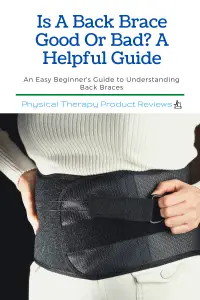You may be asking yourself, “Is a back brace bad for you?” This is a great question that many people ask themselves when they are trying to decide if back braces are right for their current pain and condition.
A back brace can provide relief in some cases, but it’s important to know what type of back brace will work best for you and your unique needs.
In addition, there are times when a back brace may actually be detrimental to your long-term recovery by causing muscle loss.
In the other instance, a back brace may be bad for you is if there is a sore or open wound that the back brace may irritate. If you have an open wound, the friction from the back brace can make it worse and increase the risk of infection
Are Back Braces Bad for you?
 This depends on your specific situation but the times where a back brace may be wrong for you is if you no longer need to use it or if there is an open wound that can become irritated.
This depends on your specific situation but the times where a back brace may be wrong for you is if you no longer need to use it or if there is an open wound that can become irritated.
For example, a back brace may be appropriate after a fracture or spinal surgery to wear for a certain period of time.
However, once you have recovered, you no longer should wear the brace because it can take over the spinal muscles. We want the back and core muscles to be the primary mode of stability for the back long term and not the back brace.
Is a Back Brace Bad for your Back?
In specific situations, it can limit your back range of motion and decrease the strength of the core and back muscles. If this weakness progresses over time then this can be bad for your back long term.
A back brace may also limit the range of motion and can cause stiffness or tightness in the back. that can be detrimental to the long-term health of the spine. Stiffness and a lack of mobility may increase the risk of injury in the future.
If you are wearing your back brace for long periods of time simply because it makes the back feel better but there is no real need or injury then, yes, a back brace can be bad for you.
When Should you Wear a Back Brace?
A back brace can provide relief in some cases, such as after back surgery, after a fracture, or if you are trying to participate in a sport with less back pain after a disc herniation or other injury.
This can be the case for many impact sports where a compression back brace can help prevent your back from going into aggravating positions.
If your doctor prescribes a back brace, then obviously, it is needed in that situation. The most common times to wear a braces after spinal fractures and severe trauma like a car accident.
Most braces are designed to be worn for a short period of time are not supposed to be worn long term except in special situations.
Are Posture Braces Bad for your Back?
No, posture braces are not necessarily bad for your back, but they may not be effective either. Posture braces pull your shoulders back and your chest up into “better posture.” However, this position is short-lived once you take the brace off, and a posture brace is only part of the solution.

In addition, you need to be strengthening the muscles of the upper back to hold you in that posture. Without changing the strength of the postural muscles your posture is unlikely to change.
Are Back Support Belts Effective?
These can be effective in certain situations and are best used in short periods such as during heavy lifting at work or potentially with low back pain during pregnancy.
Lumbar support belts are designed to compress and tighten the back muscles and joints to provide additional stability. This is perfect for people who might be hypermobile or need extra support during a heavy lift, such as lifting a piece of furniture.
Is it Bad to Wear a Back Brace all Day?
Yes, it is not recommended to wear your back brace all day long. It’s essential to try and use the back brace only when it is needed.
Examples include at work, during sports, or after a new back injury.
Even after spinal surgery, where they recommend a back brace, they want you out of the back brace for a few hours a day in safe circumstances.
This allows the skin on the back to recover and breathe, lets the muscles do their job again and activate, and allows for a break from the stiffness.
Should you Wear Your Back Brace While Sleeping?
A back brace can be a helpful tool for specific injuries, but it is essential to know if you should wear your back brace while sleeping.
If you recently just had back surgery, then it’s best to check with your surgeon, and in a lot of cases, they will have you wear a back brace while sleeping. This helps protect the new injury while it heals.
However, using a back brace for back support while sleeping is not recommended. It will restrict the back muscles and joints from moving during your sleep, leading to stiffness in the morning when you wake up.
Unless a doctor says, don’t wear a back brace to bed.
Alternative to Wearing a Back Brace
What can you do instead of wearing a back brace? The secret is not a secret at all but to do exercises, especially back, hip, and core strengthening exercises. By getting your muscles strong enough, they can act as a regular brace for your spine, and you will no longer need to wear a back brace for pain relief or activities.
You can also try other options, such as taping your back or trying a compression shirt.
Back Strengthening Exercises
You can do so much to strengthen your back and core muscles, so you may have to try different exercises to see what works best for you. Some of our favorite strengthening exercises do include:
- Planks
- Bridges
- Side planks
- Dead Lifts
- Swiss ball exercises
- Lunges
- Table hip exercises
If you recently just had back surgery, then it’s best to check with your surgeon, and in a lot of cases, they will have you wear a back brace while sleeping. This helps protect the new injury while it heals.
However, using a back brace for back support while sleeping is not recommended. It will restrict the back muscles and joints from moving during your sleep, leading to stiffness in the morning when you wake up.
Unless a doctor says, don’t wear a back brace to bed.
Try Taping Your Back Instead of Using a Back brace
Taping can be alternative support to using a back brace and is sometimes a good transition option once you wean out of a back brace. This is easy to do for yourself and is something that you can put on when you need it.
We typically have people try Kinesio tape first because it’s inexpensive and easy to use. We’ve reviewed the different types of Kinesio tape, and you can read our reviews at this link.
Here is an example of how to tape your back.
Conclusion
People get back braces because they think it’s a quick fix to their back pain, but in most cases, back braces can be more harmful than helpful.
Instead of wearing the back brace all day long, you need to strengthen your muscles so that your back is strong enough on its own without any additional support from a back brace or Kinesio tape.
It’s essential to see a back specialist if you are considering getting back surgery or wearing back braces because they will be able to recommend the right course of action for your specific injury and what is best for you.
There is also an alternative to using back braces called Kinesio taping that can help when done correctly.
GLP Weight Loss and Back Health: Effective Strategies and Insights
How to Stay Active After Cervical Fractures: Expert Tips and Advice
Dealing with Painful Stairs After Ankle Replacement Surgery
Walking After a Total Ankle Replacement: Tips for a Successful Recovery
Exercises While Non-Weight Bearing After Ankle Replacement: Elevation, AROM, Leg Raises, and More
Ankle Pain with Stairs: Causes and Home Treatment Options
Disclaimer: The information provided in this post is for educational purposes only. This is not a substitute for a medical appointment. Please refer to your physician before starting any exercise program.







